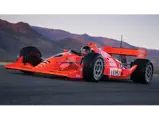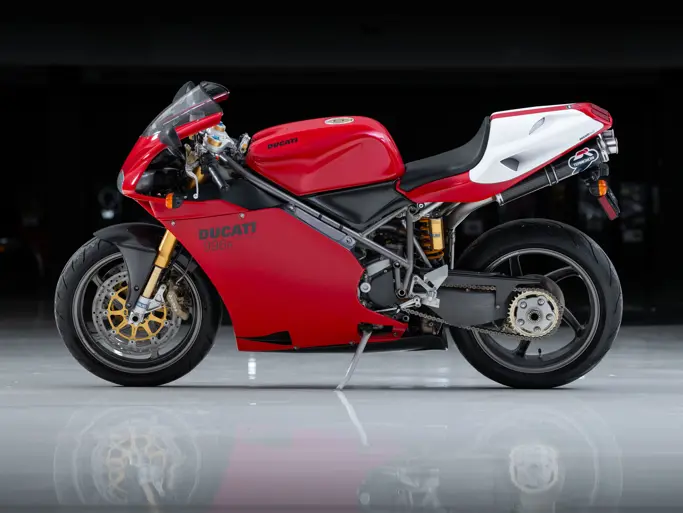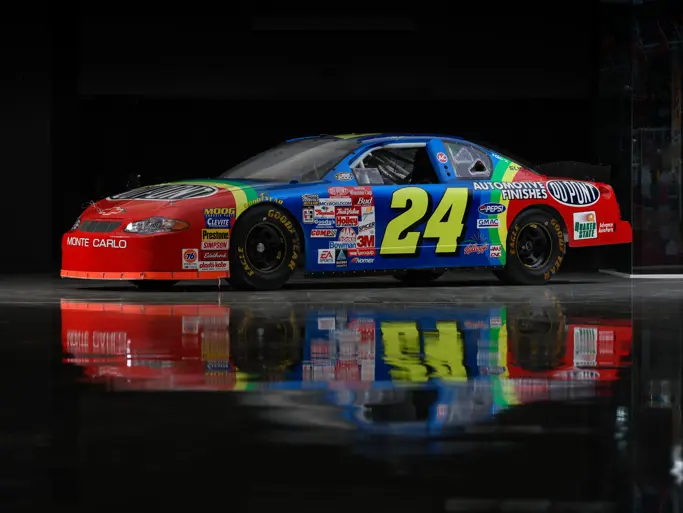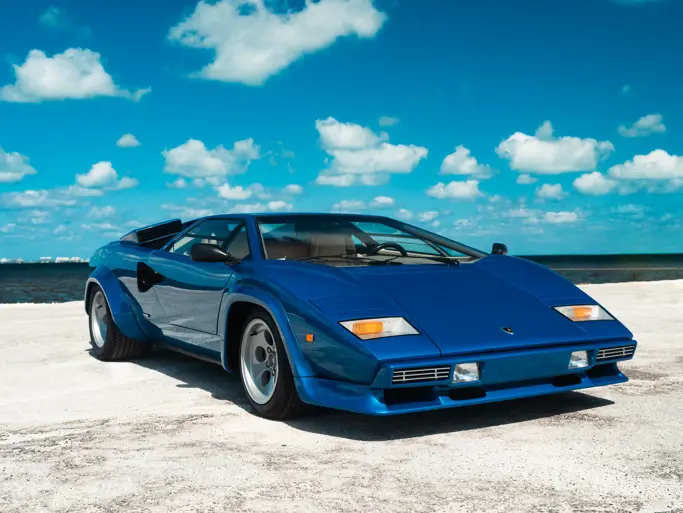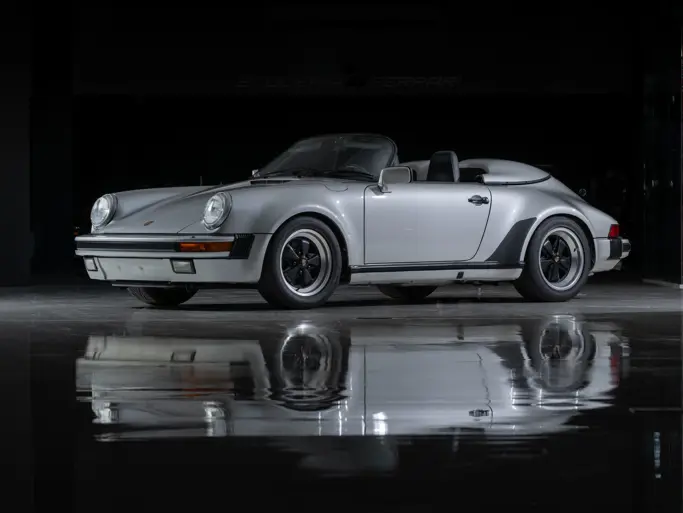California 2015
1991 Lola Chevrolet T91/00 Indianapolis
{{lr.item.text}}
$90,200 USD | Sold
 | Santa Monica, California
| Santa Monica, California
{{internetCurrentBid}}
{{internetTimeLeft}}

“Indy Car owners with a strong urge to win in 1991 and the money to back it up had an easy choice of machinery. Buy a Lola T91/00 chassis and get on the list for those eligible for Chevrolet Indy V-8 power.”
So stated the 1991 CART Indy Car season review. Roger Penske was still producing eponymously-named state-of-the-art chassis’ in 1991 with the Penske PC20, but this highly successful car was for Team Penske alone, and the Lola T91/00 proved to be its most able and steady competitor.
Michael Andretti and Newman-Haas Racing clinched the CART Indy Car National Championship with a similar “factory” Lola T91/00 to the Arie Luyendyk driven, Vince Granatelli Racing owned car that is being offered. This car, chassis T91/00-02 was an integral part of the team which finished sixth in the 1991 championship battle. The Granatelli team had three Lola T91/00’s to choose from; detailed research has shown that this car was part of the rotation between race and backup (“T” car) and had a victory in the Phoenix race, plus a second, third, seventh and ninth place finishes to its credit.
The pilot of the Granatelli Lola was the popular defending (in 1991) Indianapolis 500 victor, Arie Luyendyk. Arie had scored his first series win in Indianapolis in May 1990 in a Lola T90/00 Chevrolet that was owned by Doug Shierson and sponsored by Domino’s Pizza. Luyendyk would become a two-time Indianapolis 500 champion by winning again in 1997. Arie remains the current Indianapolis Motor Speedway track record holder having set one (237.498-mph) and four-lap (236.986-mph) records in 1996. Along with his track record, he endures as a most-popular retired driver that is still sought-out and appreciated.
His average speed in winning the 1990 race was 185.981-mph and many thought this record may not ever be broken. It was recently supplanted in 2013 by Tony Kanaan at 187.433-mph and again bested in 2014 by winner Ryan Hunter-Reay at 186.563-mph. Regardless, 23 years of holding such a record in a sport based on speed is impressive to say the least. Arie would close out his Indy Car career with seven victories from 171 starts and along the way would go from being the 1984 Indy 500 Rookie of the Year (finishing seventh in his debut) to being inducted into the Motorsports Hall of Fame of America.
According to Gerald Swan at Lola Heritage, T91/00-02 was sold to Doug Shierson, Luyendyk’s 1990 team owner. About midway through the 1990 season, Shierson sold 50-percent of the stake in the team to businessman Bob Tezak, owner of International Games (makers of UNO). At the time, Shierson’s sponsor, Domino's Pizza, was facing legal issues stemming from their "30 minutes or it's free" delivery guarantee. During the history of the team sponsorship, the Shierson entries traditionally carried the number 30, as a gesture to the "30-minutes or free" delivery policy. Delivery drivers are said to have felt pressure and reportedly broke laws to accomplish this task and when one incident went horribly wrong, Domino’s officials deemed sponsoring a racecar inappropriate given the circumstances and its image in balance.
Facing sponsorship uncertainty, and having accomplished his main goal in motorsports by winning the Indy 500, Shierson sold the entire team (Lola T91/00-02 included) outright to Tezak in January 1991. Tezak took over the team and would merge with Vince Granatelli Racing to form as UNO/Granatelli Racing. The team cars would now be painted in the readily identifiable dayglow orange (made famous by Vince’s dad, Andy, during the STP sponsorship years) and Luyendyk was retained as the driver of the newly formed team. Vince would run the day-to-day operations of the team, while Tezak tended to sponsorship and funding.
The young team was mightily strengthened by adding Morris Nunn as the engineer, Peter Parrott as the team manager and Bill Pappas as the crew chief. Nunn would become one of the most respected engineers in the sport during his stint with the highly successful Ganassi team during the Zanardi and Vasser years. Peter Parrott spent many successful years with Team Penske and was universally respected in the racing community. Pappas is currently a highly-sought-after veteran engineer who is working with KV Racing for the 2015 season and recently won with driver Sebastian Bourdais at Detroit in race two on May 31, 2015.
Few teams have accomplished so much under the trying conditions that the UNO/Granatelli team would find themselves in as the 1991 season progressed. The successes they achieved are a testament to the car, engine, driver and team that never lost focus of their job of competing and winning at this high level.
As the season developed, the UNO/Granatelli team suffered thoroughly from a lack of sponsorship money, which caused friction as the season endured. RCA sponsored the car at Indy, but for some races the Lola had blank sidepods.
The team nearly folded in the June and July timeframe when Tezak announced he was out of money, and pulled his support. Granatelli battled a restraining order from Tezak and Total Petroleum, which prevented them from taking to the track at the Michigan 500 in August for practice and first day qualifying. The order was lifted, and Luyendyk nearly won the race, finishing a close second to Rick Mears. Despite two wins and a sixth place finish in points for 1991, the team closed its doors permanently at the conclusion of the 1991 season.
This Lola’s CART race history was recently compiled and verified by Mr. Richard Perry, who was the CART Technical Director for many years, including the 1991 season. He is a CART-era Indy Car historian by having the foresight in period to make notes of the various team cars by charting the correlation between the CART number that was assigned to each monocoque and the car’s chassis tag, which came from the manufacturer.
With these parameters, Mr. Perry’s thorough research shows that Lola T91/00-02 with CART number 410 ran in six races for Granatelli Racing during the 1991 season. It was also the backup, or “T” car in three other CART events. Donald Davidson, historian at the Indianapolis Motor Speedway, conveyed during phone conversation that chassis 91/00-02 was the number 1T backup to T91/00-28 during the month of May for the running of the Indianapolis 500, in which Luyendyk would finish third to Rick Mears and Michael Andretti.
The race history in CART for this car shows that it was the primary car in Australia as the season commenced at Surfer’s Paradise. Luyendyk would start eighth and finish ninth, but this was considered somewhat fortunate as described by Arie in On Track magazine coverage that begins with the Lola catching fire during his second pit stop. “I pulled away too early and took the whole crew with me. When the car comes down off the jacks, it’s always been my signal to go – but it’s different with this team. I guess we’re going to have to communicate better.” Arie bailed out of the car at the exit of pit lane and the track marshals quickly doused the flames. After the Lola was pushed back to the Granatelli pit, it was cleaned up; Arie was strapped back in and resumed, albeit with shocks that were virtually inoperable after being fried in the fire.
The next stop in Long Beach, California saw this car as the backup, while T91/00-22 was utilized for this race. On to Phoenix for the one mile oval that was also home to UNO/Granatelli Racing and also Arie Luyendyk. This race saw T91/00-02 in as the primary race car with -22 now in the backup role. After qualifying ninth in a strong field Arie commented “It sucks. We picked up an understeer and I had problems with my pop-off valve also.” On raceday, Luyendyk ran among the lead pack until the first full-course caution came on lap 35. At that point he was a steady P8; rather than pit with the other leaders, he was instructed to stay out and suddenly found himself in the lead. From there, the strategy, along with being suitably motivated and driving excellently he held off challenges from Team Penske’s Emerson Fittipaldi and Galles-Kraco’s Bobby Rahal. After additional pit sequences, Luyendyk swept through to the lead again on lap 100 (half distance) and from there he was virtually unchallenged and scored a remarkable victory in this very car. “I’m happy for myself of course, but I’m also happy for my team. We’ve got a great group of people. Everything came together late, just early in the New Year. We’re trying to gel together as a team, and I think it’s all come together sooner than we thought.” It was a massively popular win for Arie in his adopted “hometown” and the locally-based Granatelli team.
This victory created a great springboard to head to Indianapolis and attempt to repeat his 1990 victory. In 1991 USAC sanctioned the Indy 500 and as it was its only Indy Car event, Arie and the Granatelli team were honored to run with the coveted number one on the Lola; it ran with number 9 for the balance of the season in CART. As mentioned above, T91/00-02 was stated by Donald Davidson to be assigned the “1T” number at the Speedway while -028 was the primary car number “1”. While Luyendyk would finish third in the race in the T91/00-28 chassis, -02 would also see a great deal of track time as the backup had to be ready to go in a moment’s notice should something unexpectedly befall the primary car.
The Indianapolis 500 Yearbook by Carl Hungness confirms that -28 was indeed the raceday car, and the daily track reports often mention Arie taking out -02 and running nearly as quick as the primary car in the daily practice sessions. The exceptional Indy Car on offer was also the center of attention when the UNO/Granatelli team was trying to fill this sought-after “T-car” seat with four-time Indianapolis 500 winner Al Unser. The car, driver and team were more than capable, but the Chevrolet engine agreements of the period disallowed more than a certain prescribed number of powerplants to be used and the deal fell through and deprived T91/00-02 of being driven by two Indy 500 winners in the same season. This is an interesting anecdote and part of the mystique and intrigue that can be found in the stories surrounding well-known racecars like this. The qualifying speeds at the sharp end of the grid for Indianapolis in 1991 were around the 224- to 225-mph region; quite similar to today’s speeds at the Brickyard.
The next weekend in Milwaukee, T91/00-02 was again the primary car for the race event. Arie had lived in Milwaukee for many years before his Phoenix relocation and was hoping to give his other “local” fans a repeat of the Phoenix victory. After scrubbing in all of his allotted tire sets in practice; the team ended up a disappointing 14th on the grid due to being caught out by the latest Goodyear tire compound being fastest unused by nearly half a second. A strong effort in the race was for naught when the right rear suspension collapsed on lap 128 of 200 while running fifth. “I was running pretty good, related Luyendyk, but turning into turn three, the car just went straight on. I pulled every trick in the book to keep it away from the wall.” No contact occurred prior to the breakage or afterward. Luyendyk’s second place in the points at that time took the hit instead.
The street circuit through the Renaissance Center area of downtown Detroit was the next race on the CART Indy Car schedule and Luyendyk and Granatelli racing would qualify fourth and finish third in a race that could have gone far worse. In the later stages of the race, there was a blocked track situation that caught up Luyendyk in T91/00-02 and he had to come to a stop with the engine overheating to the point where it lost its true effectiveness and he nursed the ailing Chevrolet Indy V-8 into a fine third place.
Portland International Raceway was the next race for Lola T91/00-02 and Luyendyk struggled in finding good balance getting out of the corners and was trying to figure out how to limit the oversteer on corner exit. He and engineer, Mo Nunn struggled to find the proper speed they expected in the car all weekend and doggedly ran the race amongst the top ten, eventually finishing seventh. While it was apparent from the season’s beginning that the Granatelli group had fast oval cars, they were gaining on the street and road courses for a desirable overall package of competitiveness.
The CART records show that Lola T91/00-02 was not raced again until the Michigan 500 in early August 1991. In late July it was announced that the partnership between Granatelli and Tezak had broken down to the point of a split. Sponsorship had been a nearly season-long concern with many issues being wrangled behind the scenes. It was understood that legal proceedings might be forthcoming between the two as all were drawn into the settling of financial obligations. The car was seen at certain summer races basically devoid of sponsorship. At the time, the racing press covered the story in the manner befitting the previous year’s Indy 500 winner and one of the most popular drivers in the series.
Following court action, the Granatelli team was able to compete at Michigan after a Michigan State court judge lifted a temporary restraining order brought by Total Oil. Total was to have paid Tezak to be on the car throughout the season. After the buyout, Granatelli had the Total signage removed since no money had actually been paid to Tezak or Granatelli. The judge agreed and the team was free to start its preparations for the Michigan 500. After being forced to sit on the sidelines for the first two days, Luyendyk took to the track for the first time on Saturday morning and would perform brilliantly on raceday after qualifying 20th at 222.910-mph on the two-mile oval with 18-degree banking through the corners. Crew chief Bill Pappas commented that “what we’re going to do is annoy the people at Indianapolis by proving that you can prepare for a 500-mile race in less than 24-hours.” He proved true to his word. Luyendyk would move up quickly from his starting position and be in contention throughout the day to finish a strong second in T91/00-02. The second place represented a remarkable achievement; from the well-publicized court injunction and lack of running time to Luyendyk, Nunn and Pappas quickly arriving at a good setup, to the Dutchman parlaying the hard work into a “brilliant drive in the race,” according to On Track magazine reports of the period.
Luyendyk achieved this finish after receiving a stop-and-go penalty on the restart of the race following the eighth caution period on lap 182 of 250. Luyendyk was adjudged to have been a bit over-zealous on the restart according to the CART officials. He passed John Andretti, who was four laps down, before the green flag flew at the start/finish line. Team owner Granatelli disputed the call, but it stood based on multiple confirmations by the officials at observer stations 6 and 7, plus Race Control. This writer was a CART-licensed official and was corner captain that day at station six and was involved in the call of Arie passing under yellow in this situation. Fortunate to see the car in action many times in 1991, it is just as eye-catching and memorable today as 24 years ago. This period of Indy Car is considered by many fans, as well as many participants, a quintessential design of America’s premier open wheel series.
The Michigan 500 was Luyendyk’s 100th start in an Indy Car and he was content with the fighting second place. He and Rick Mears battled for the win; Arie commented, “my car was really good at the end of the race, but once a gap had established itself, it’s hard to catch up. I gave all I had but I didn’t quite have enough to pass Rick.” Mears and Arie both turned their fastest laps of the race at the end with Rick running a 32.04 (224.719-mph) on his penultimate lap and Luyendyk matching it on his final tour and finished just over three seconds back. Arie was a columnist in On Track at the time and in his “Going Dutch” column he commented “We picked up a lot of money, as well as a lot of good publicity in USA Today and some other publications. That means a lot to our team, not only for this year, but it can’t hurt in our efforts to gain sponsorship in 1992…..we have something special and I, for one, know it’s the best team I’ve ever driven for.” As things would have it, Arie signed with and raced for Chip Ganassi the following season. This hiring by Ganassi was a fine reward for the yeoman efforts displayed in the Granatelli Lola’s, of which this car plays a major role.
As the season wound down, T91/00-02 would be the “T” car on two final occasions at Denver and then Vancouver. So ends the confirmed racing history of this well-known Lola chassis. At this point in time, year-old chassis’ were rarely used by the top teams who opted for the redesigned and freshly constructed new models. Based upon the sanctioning body tags attached in the tub being associated to 1991, as seen with both the USAC number and the CART number, it is thought that this car has seen track time in these select six races in its career, as well as the laps turned as the backup. After being retired from active open wheel racing at the highest American level, it is unknown how it spent the ensuing years before being beautifully restored to the highly-desirable running example before you.
The Lola name is synonymous with speed and quality, as is the Chevrolet Indy V-8 engine which made a huge change to the face of Indy Car racing as it phased out the previously all-conquering Cosworth DFX turbo engine and led the way for Ford to awaken to the Chevy challenge with its new Cosworth XB unit in the 1992 season next to the newly introduced Chevy "B". These engines are 2.65-liters, 720-hp at 11,000-rpm and power an approximately 1,500 pound racecar. Any way you look at it, these cars are amongst the fastest on the planet. They were meant to hug the earth, and yet, they fly.
The Granatelli name and the florescent orange paint is part of a racing lore that dates back to Vince’s father, Andy and his brothers making their way in the world of speed and culminating with Mario Andretti’s 1969 Speedway victory in Andy’s STP Brawner/Hawk-Ford. This car features the proper Lola wheels which were cast with all-important aerodynamics in mind, it has the uncommon and very desirable running Chevrolet Indy V-8 turbo, associated gearbox, a hard to find pop-off valve, proper graphics for full early-season sponsorship, Goodyear Eagle racing tires, proper chassis tag, correct USAC and CART tags, racing harness, computer dashboard and what appears to be a wing package set up for road or street courses. The car exhibits the proper details and the presentation is well-executed throughout.
Lola T91/00-02 has a well-documented history that is associated with some of the biggest names in the sport in the period in which it ran. With Arie being the defending Indianapolis 500 champion, the team was often featured in magazines and books of the time. When you add in the legal battles and intrigue that surrounded the team on its way to a very respectable sixth place in the final championship standings, it represents a sound testament to the efforts of a small, yet very strong team that earned two wins (Phoenix in T91/00-02 and Nazareth in T91/00-22) during the 1991 season. Out of T91/00-02’s six events, it finished out of the top ten just once, and this was due to suspension failure while running fifth; an enviable record indeed.
A fine example of the archetypal 1990s Indianapolis racer, this Lola Chevrolet will be a worthy addition to any comprehensive collection of competition cars.

